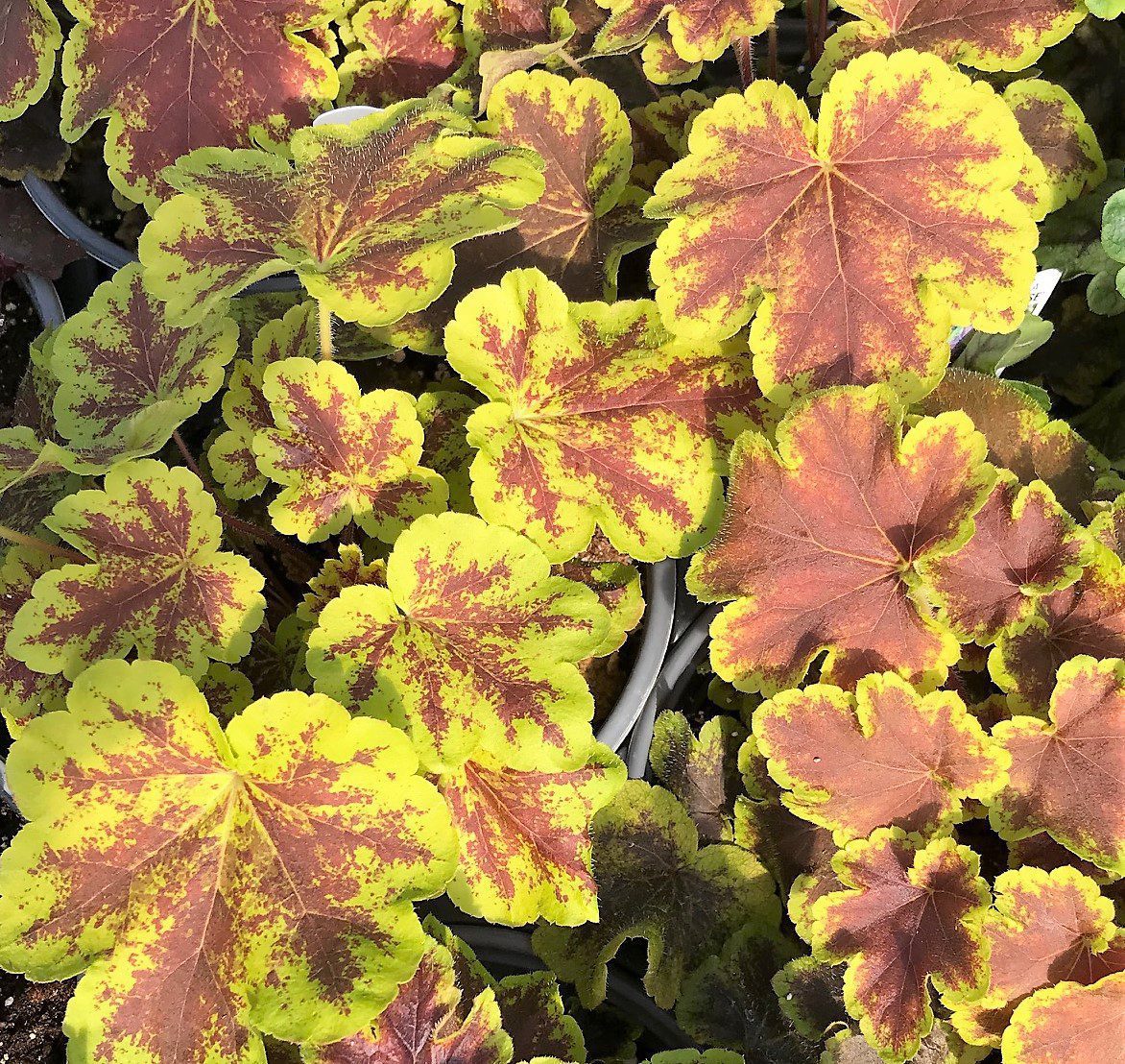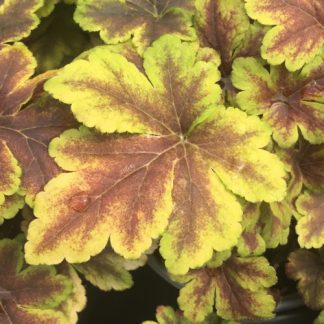Description
Heucherella ‘Solar Eclipse’: A Garden Showstopper That Glows All Year
Meet the Marvel of the Shade
Heucherella ‘Solar Eclipse’ lights up dim corners like a playful sunbeam. Part Heuchera, part Tiarella, this hybrid blends the best of both parents—show-stopping color from Heuchera and vigorous, shade-loving hardiness from Tiarella. Dark chocolate centers rimmed with a neon red-orange halo set each scalloped leaf aglow. Even in the low light of early morning or late afternoon, the foliage seems back-lit, pulling our gaze again and again.
A Brief Backstory
Plant breeders sought foliage that wouldn’t fade in summer heat, and flowers that would still charm pollinators. The solution: cross a robust Tiarella with a richly colored Heuchera. After careful trials, ‘Solar Eclipse’ emerged. It has held its color through sizzling July afternoons and chilly October nights, proving rugged as well as radiant.
Why We Love This Hybrid
- Four-Season Foliage: Leaves stay colorful spring through fall, only going to sleep under a low blanket of snow.
- Compact Habit: Tidy mounds reach about twelve inches high and eighteen inches wide. Perfect for borders, containers, or edging shady paths.
- Pollinator Power: Airy spring blooms lure early bees when little else is flowering.
- Deer Resistant: While deer nibble many plants, they usually skip Heucherella, freeing us from constant worry.
- Easy Care: Once established, the plant sails through periods of light drought with minimal fuss.
Best Spots in the Garden
Dappled Understories
Slip a few plants beneath high canopies of dogwood or Japanese maple. The glowing edges outline each leaf against deep shade, giving depth and contrast.
North-Facing Entryways
Front doors facing north rarely see full sun. Pots of ‘Solar Eclipse’ on both sides create an inviting welcome, echoing the warm tones of brick or natural wood doors.
Mixed Containers
Combine with chartreuse hostas, silver ferns, and trailing ivy. The chocolate-red leaves provide the anchor, while surrounding textures weave a living tapestry.
Woodland Borders
Edge winding woodland paths so visitors feel guided by small glowing lanterns. The neat mounds also keep paths clear and defined.
Designing With Color
The unique color band on each leaf gives us an easy palette cue. Pair with:
- Blue-Green Companions: Blue hostas or brunnera cool the fiery halo, creating balance.
- Gold Accents: Golden hakone grass or creeping jenny picks up the red rim and turns it into a warm harmony.
- Deep Purples: Dark ajuga or black mondo grass extend the chocolate centers into richer shadows, letting the red outline shout even louder.
Mix and repeat in drifts of three or five plants for rhythm that guides the eye from bed to bed.
Care That Anyone Can Master
Soil
Loose, well-drained, and slightly acidic soils suit the plant best. Add compost before planting to keep roots happy. Avoid heavy clay or standing water, which may lead to root rot.
Light
Morning sun followed by afternoon shade is ideal. In cooler regions, light dappled shade all day works well. Harsh southern sun can bleach color, so offer protection during peak hours.
Water
Water weekly during the first growing season. After that, a deep drink every ten days in dry spells is usually enough. Mulch keeps moisture in and roots cool.
Feeding
A light sprinkle of balanced, slow-release fertilizer in early spring jump-starts growth. Too much nitrogen only pushes soft green leaves, so go easy.
Pruning
Snip faded flower stems to encourage fresh blooms and maintain a clean look. Remove any tired or winter-burned leaves in early spring to reveal new growth beneath.
Propagation
Division
Every three to four years, lift the clump in early spring. Separate outer offsets, each with roots attached, and replant right away. This refreshes vigor and doubles plant stock.
Leaf Cutting
Though slower, rooted leaf cuttings in late spring can yield new plants. Dip the base in rooting hormone, tuck into sterile media, and keep lightly moist. New roots appear within six weeks.
Dealing With Pests and Troublemakers
- Vine Weevils: Their notched chewing shows on leaf edges. Apply beneficial nematodes to soil in late summer when larvae feed on roots.
- Rust or Mildew: Good air flow prevents fungal troubles. Water at soil line, not over leaves.
- Slugs: Use copper tape around containers or scatter iron phosphate pellets at night.
Luckily, most seasons sail by with no more than a gentle rinse from a hose to knock off dust.
Sustainable Advantages
Heucherella ‘Solar Eclipse’ supports early pollinators and offers long foliage interest, reducing the need for high-maintenance annuals. Once established, it needs less water than many shade annuals, saving resources. Because deer pass it by, gardeners can skip harsh repellents, letting natural cycles roll on.
Combining With Hardscape
Picture a weathered stone wall with a crevice just wide enough for a root ball. Slide ‘Solar Eclipse’ into the gap, press in compost, and watch the leaves spill over the edge like molten bronze. The plant’s warm edge softens hard textures while echoing earthy stone tones. On timber decks, glazed ceramic pots in teal or charcoal frame the foliage and create a modern look.
Seasonal Show
Spring
Fresh leaves unfurl with bright edges glowing against the moist earth. Flower spikes rise like tiny sparklers, drawing bees that have just woken from winter sleep.
Summer
Heat settles in, yet colors stay bold. Pair with coleus and impatiens for a shade bed that sizzles even on the hottest afternoons.
Autumn
Cool nights deepen the red margin, turning leaves into mini campfires. Under maples gilded with orange, the effect is breathtaking.
Winter
In milder zones, evergreen leaves stay present, though tones mute a bit. In colder regions, foliage flattens under snow but bounces back come spring without complaint.
Growing Indoors
If you crave year-round color inside, pot up ‘Solar Eclipse’ in a bright east-facing window. Rotate the container weekly for even growth, and keep soil lightly moist, never soggy. The plant enjoys cool nights, so a slightly chilly windowsill is perfect.
Kid-Friendly Garden Activity
Invite children to trace leaf outlines on paper, then color the centers chocolate brown and edges bright red. They learn plant anatomy while enjoying an easy art project. Later, head outside to spot the living version, connecting art with nature.
Community Garden Value
In shared plots, dependable perennials that stay compact earn universal applause. ‘Solar Eclipse’ fills that role, attracting bees without spreading aggressively. Its eye-catching foliage invites conversation and introduces new gardeners to the joys of shade gardening.
Troubleshooting Quick Guide
| Problem | Likely Cause | Simple Fix |
|---|---|---|
| Leaves fade to green | Too much sun | Move plant or provide dappled shade fabric |
| Center dies out | Age or poor drainage | Divide in spring, replant in fresh compost |
| Wilting despite moist soil | Crown rot | Lift, trim rotted tissue, replant in raised bed |
Refer to this table when you notice changes and solve issues before they snowball.
Crafting With Cuttings
Heucherella leaves make charming accents in small bouquets. Their unique bicolor rim frames pastel blooms like an artist’s mat. Float individual leaves in shallow bowls for instant table décor, or press and dry them to embellish greeting cards.
Pairing With Wildlife
Early flowers serve hungry native bees. Beneficial insects often shelter under the mounded canopy during hot afternoons. By planting ‘Solar Eclipse’, we provide micro-habitats that keep backyard ecosystems humming.
Landscape Plans in Practice
- Moonlit Patio: Combine three ‘Solar Eclipse’ plants with two silver lamium and one white astilbe in a half-barrel planter. At dusk, leaves gleam, and white blooms glow.
- Woodland Edge Curve: Alternate clumps of ‘Solar Eclipse’ and golden Japanese forest grass along a curved path. The repeating pattern leads walkers through the shady turn like stepping-stone lights.
- Rain Garden Border: Place on the slightly raised edges where soil drains well, letting the plant frame moisture-loving ferns at center.
Future Breeding Promise
The success of ‘Solar Eclipse’ encourages breeders to chase even wilder color rings and stronger stress tolerance. We can look forward to next-generation hybrids that thrive in deeper shade, hotter sun, and colder winters, giving gardeners everywhere a brighter palette.
Quick Reference Cheat Sheet
- Botanical Name: × Heucherella ‘Solar Eclipse’
- Hardiness: USDA Zones 4-9
- Height/Spread: 12 in. tall × 18 in. wide
- Light: Morning sun to full shade
- Soil: Moist, rich, well-drained
- Bloom Time: Late spring to early summer
- Flower Color: Creamy white to pale pink
- Foliage: Dark chocolate centers edged in burnt red-orange
- Uses: Borders, containers, woodland gardens, edging
- Maintenance: Low—mulch, water, divide every 3-4 years
Embrace This Living Eclipse
By adding Heucherella ‘Solar Eclipse’ to our gardens, we invite year-round drama that asks for little yet gives so much. Let its glowing rims guide footsteps down shady lanes and cheer us on cool mornings when little else is awake. With simple care, thoughtful placement, and a touch of creativity, we share in the quiet magic of a plant that refuses to hide in the dark.




